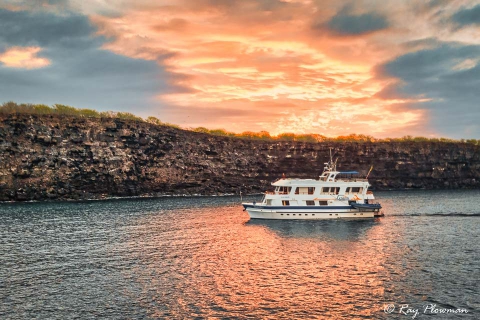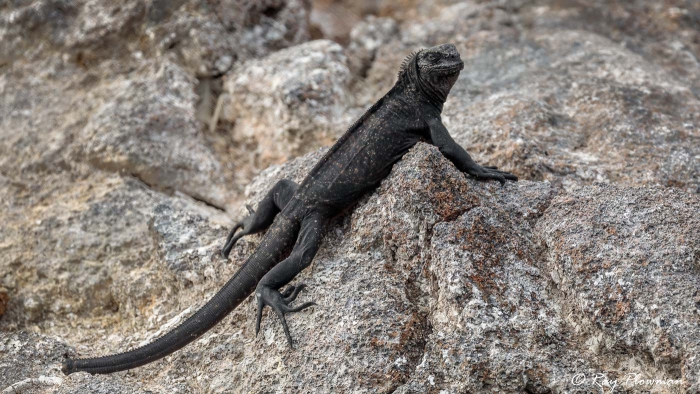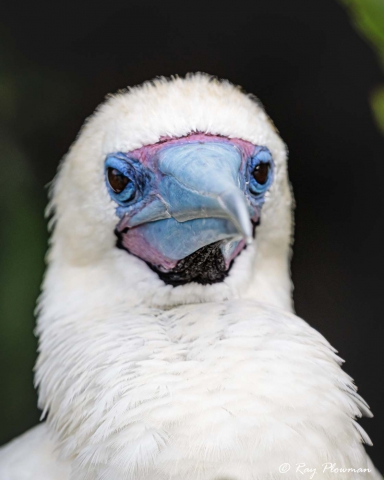Genovesa – Darwin Bay, Prince Philip’s Steps
On day fourteen, we visited Genovesa – Darwin Bay and Prince Philip’s Steps. The last full day island on our tour and by far the best for seabirds.
Genovesa is the most isolated of the visitor accessible islands, located in the northern part of the archipelago. It is the low flat top of a shield volcano about 200 ft above sea level. Furthermore, the volcano’s caldera collapsed on the south side, and the submerged crater formed Darwin Bay. Because of its remoteness, many land species are absent, and birds dominate hence also known as bird island. It is an arid zone island with sparse vegetation such as scrub, mangroves, Palo Santo trees, Opuntia cacti and bushes. It is an uninhabited, pristine island with an abundance of nesting seabirds.
The National Parks code of staying greater than two metres from wildlife does not apply to Genovesa. It would be impossible to meet.
Darwin Bay
We anchored in Great Darwin after the long voyage to Genovesa (Tower) from Santiago’s Sullivan Bay.

Further, the anchorage was close to the east cliffs, the perfect backdrop to the sunrise, especially as Angelito I arrived.
We made an early morning landing on Darwin Bay Beach (Playa Darwin). Most birds are seabirds; however, there are also a few landbird species, such as finches and mockingbirds. Furthermore, there are only one reptile species on Genovesa, the marine iguana.

Galapagos Marine Iguana at Darwin Bay Beach
The Galápagos Marine Iguana (Amblyrhynchus cristatus nanus) climbing on the rocks at Darwin Bay Beach. It is a Galápagos subspecies endemic to Genovesa and the smallest marine iguana in the archipelago.
Gulls and Seabirds at Darwin Bay Beach
[foogallery id=”17297″]
Gulls and Seabirds at Darwin Bay Beach
Once ashore, we followed the trail that skirted the tiny bay before heading east along the coast and onto firmer ground. The first gallery above features seabirds and swallow-tailed gulls. Swallow-tailed gulls were nesting on the ground, some on the beach, others amongst lava rocks and crevices. I got a curious look from a pair preening on a cliff ledge.
There were only a few Nazca boobies here; they nest on the ground. I photographed one tending two eggs in a nest constructed from small stones and twigs. Nazca booby’s strategy is to lay two eggs but raises only one chick. If both eggs hatch, then the older chick would commit siblicide. Red-footed boobies only lay one egg, while blue-footed boobies lay two to three eggs and raise more than one chick.
The gallery features several great frigatebirds perched in bushes; a male, female, juvenile and a pair of juveniles displaying.
About halfway along the trail, hidden in an Opuntia cactus, was a red-billed tropicbird chick. When we came back later, an adult was also at the nest, but as we approached, it flew off.
Nazca Booby Breeding Colony Photo Essay
Red-footed Booby Breeding Colony Photo Essay
[foogallery id=”4384″]
Red-footed Booby Breeding Colony Photo Essay
The gallery displays three types of red-footed booby morphs: white, intermediate, and brown. In addition to the adult portraits, both a juvenile and chick feature. Furthermore, images of red-footed booby images show egg incubation and preening. Moreover, on Genovesa, they nest in the mangrove trees.

Red-footed Booby Morphs
The image features a white morph red-footed booby at Darwin Bay Beach.
On most islands around the world, the predominant colour morph is 95% white, with white-tailed brown morphs accounting for the other 5%. On Genovesa and Wolf islands in the Galápagos, red-footed boobies morph exhibit a reverse ratio with about 90% brown and only 10% white (Ref 1).
As expected, most of the photos were brown morphs with a few white and one intermediate. Unfortunately, the tail is not visible in one white morph image; this individual seemed much whiter than other white morphs I photographed.
Landbirds at Darwin Bay Beach
[foogallery id=”17306″]
Landbirds at Darwin Bay Beach
The gallery features a large ground finch, Genovesa cactus finch (Geospiza propinqua), an endemic island species and Galapagos mockingbird (Mimus parvulus bauri), an endemic island subspecies.
Prince Philip’s Steps
Back on board for lunch, then a panga around the bay to land at Prince Philip’s Steps (El Barranco). In the early afternoon, a dry landing on rocks leading to a steep stairway to the top of the cliff. We climbed the steps for the second great walk of the day. At the top, Nazca boobies were nesting on the ground. The trail heads inland, passing through the arid reddish lava landscape sparsely covered with Palo Santo trees that provide some shade. After reaching the end of the walk, we backtracked to the steps.
The first gallery below features seabirds and landbirds, while the second is a Nazca booby photo essay.
Seabirds and Landbirds at Prince Philip’s Steps
[foogallery id=”17307″]
Seabirds and Landbirds at Prince Philip’s Steps
Featured images: Red-billed tropicbird chick in an underground lava void. Great frigatebird perched in a Palo Santo tree. Red-footed booby collecting nest material. Brown morph perched in a tree and a chick in a nest. And two different short-eared owls – one perched in a cave at the trail end and the second under the shade of a tree.
Nazca Booby Breeding Colony Photo Essay
[foogallery id=”4406″]
Nazca Booby Breeding Colony Photo Essay
Prince Philip Steps on Genovesa Island was the second Nazca booby nesting site we visited in the Galápagos.
When I processed one of the Nazca booby images, I noticed dark patches on the bird’s neck. These are blood-feeding ectoparasites (Olfersia aenescens), a species of Hippoboscid flies (Hippoboscidae family). On close examination of several other images, these parasitic flies were on many Nazca boobies, often buried in the feathers. The closeup image shows the parasites on an infected birds head and neck.
The final series of images shows a chick/young juvenile with no parent in attendance. The dead chick may have been in the hot sun too long; the risks of only raising one offspring are apparent. Next, an adult shading a young bird from the tropical sun. And finally, a sequence of three photos showing an adult feeding a chick/young-juvenile bird.
Red-footed Booby Breeding Colony Photo Essay
References and Bibliography – Online Resources
1. Galapagos Geology on the Web – Genovesa 2021. [Online] Available from Galapagos Geology on the Web [Accessed 11-Oct-21].
2. Maintenance of Plumage Polymorphism in Red-Footed Boobies in the Galápagos Archipelago: Observations of Mate Choice and Habitat Association 2008. [Online] Available from BioOne [Accessed 11-Oct-21].
3. Global Volcanism Program – Genovesa 2013. [Online] Available from Smithsonian Institution National Museum of Natural History [Accessed 11-Oct-21].